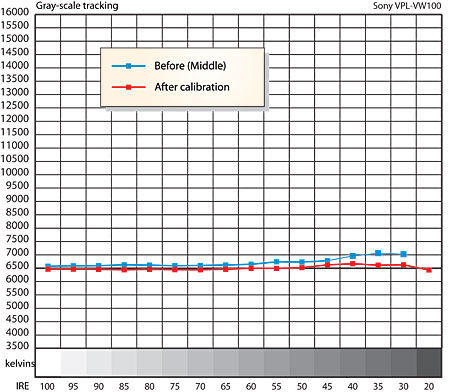Sony VPL-VW100 SXRD Video Projector Part II Further Tests and Calibration
The most accurate preset color temperature prior to calibration, with the iris in Auto, was the in the Middle setting of the Color Temperature control ("Before" in the chart). While the Before results were good, and produced a very watchable color balance, the measurement numbers were minus green. After calibration, the readings were very close to the desired D6500, varying by more than 0.002 from the specified D6500 x/y coordinates at only three points in the low brightness range, where the coordinates were off by +/-0.003! (A tolerance of +/-0.004 is normally considered a very good result.)

Changing the dynamic iris from "Auto" to "On" after the calibration without changing anything else raised the color temperature to over 8000K. If you get a calibration performed on your VPL-VW100 (and having just dropped $10K for a projector, why wouldn't you want to get the best performance out of it?) it should be calibrated in the iris position you plan to use most often. And I see no good reason why that position shouldn't be "Auto." (You should wait until you have 100 hours or so on any new lamp to give it time to stabilize before having a calibration done.)
The color temperature remained acceptably consistent as the resolution of the source changed from 480i to 1080i and points in between. But there was enough of a difference between the results in HDMI and component that I recommend a separate calibration for these two inputs (and if you have any critical S-Video and composite sources I recommend checking the setup for them as well).
While the Sony provides a Color Space adjustment with two positions, Normal and Wide, this control had almost no affect on the color points, though Wide did increase the intensity of the some of the colors. In both cases, only blue was reasonably close to either the ATSC (DTV) or NTSC standards (which are slightly different from each other, though close enough that switching from one to the other produces only a barely perceptible change). Red and green, in particular, provide a wider gamut than the either of the standards calls for. While this sounds like a good thing, a mismatch between the color gamuts of the source (all of which are—or should be—mastered to either ATSC or NTSC standards) and the display will inevitably distort the colors you see.
Having said that, there is nothing visibly unnatural or displeasing about the Sony's color reproduction, but this display wouldn't be the best choice in a situation, such as a mastering facility, where decisions are being made about precise color balance. Color points closer to the standard were available in the "Normal" setting of the color space control on Sony's flagship Qualia 004 SXRD projector. The Qualia is far more expensive, but it would not seem to be a matter of cost to get this characteristic right.
Sony's Real Color Processing (RCP), in theory, allows the user to adjust the colors of the projected image. In practice, however, while some changes were visible, the adjustment altered neither the color temperature nor the color points as measured by our Photo Research colorimeter. It's one of those "adjust to taste" features that I prefer to leave Off.
The operation of the Advanced Iris changes the average illumination level of the image depending on the APL (Average Picture Level) of the source, opening up and brightening the image when the input APL is high (a bright picture), and closing down when it is low (darker scenes). While it can be fooled, I was rarely conscious of the operation of the iris on normal video material. But it does have one characteristic that affects how we measure and judge the projector's contrast ratio and gamma curve (gamma was discussed in the main section of this Part II, above).
With most displays that lack a dynamic iris (apart from plasmas), the measured peak light output will be nearly the same whether the source test pattern is a full white field at maximum APL (100IRE from Title 18, Chapter 14 of the original Video Essentials, for example), or a 100IRE window pattern (a small 100IRE white square surrounded by black, such as Video Essentials Title 17, Chapter 32). But a dynamic iris reads that window pattern as a considerably lower APL than a screen at full white. So it closes down a bit.
In the case of the Sony, that contraction is significant. With 200 hours on the Sony's xenon lamp, I measured 13.9 foot-Lamberts with a full 100IRE white field, and 7.6fL with a 100IRE white window (to the nearest tenth of a foot-Lambert, on a Stewart Studiotek 130 16:9 screen, 80-inches wide, gain 1.3, Cinema mode, contrast set just short of white clipping). That's a reduction of almost half.
While this characteristic does not reduce the projector's output on really bright scenes, where the full 13.9fL will be available (and on the specified screen the Sony never lacked for sufficient brightness), it does raise a question about measuring the peak contrast ratio. Since the APL of a real image rarely exceeds the APL of a 100IRE white window, is it more realistic to measure the peak contrast on a projector with a dynamic iris like the Sony using the window result, or is the full field white reading more revealing?
I'll report both results, you decide. At that 200 hour point, I measured a peak white window contrast ratio of 3778:1 (7.556fL peak/0.002fL video black), and a peak full field white of 6955:1 (13.91fL/0.002fL). Take your pick. Either way, the peak contrast is impressive, if not quite as impressive as the advertising claims (which are optimistic industry-wide, and rarely measured at settings that produce the best-looking, best-calibrated image.)




























































